
The Nokia 9210 Communicator is a third-generation Communicator series mobile phone produced by Nokia, announced on 21 November 2000 and released in June 2001. It greatly improved on the second generation Nokia 9110 Communicator, providing a colour main screen and using an ARM processor. It is one of the few mobile phones able to send and receive fax.

The Nokia 6600 is a mobile phone introduced on 16 June 2003 by Nokia, costing approximately €600 when released in October 2003. It was part of Nokia's high-end model of the 6xxx Classic Business Series. It runs on Symbian OS 7.0s. It also featured a VGA camera, a music player and video player, Bluetooth and a memory card slot, being the second non-Communicator to do so.
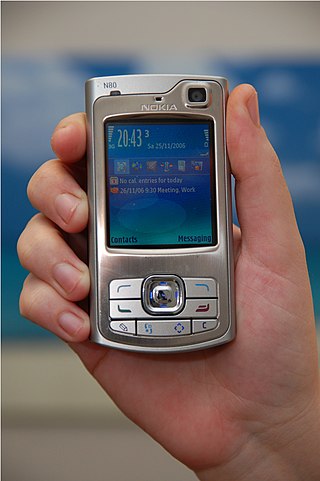
The Nokia N80 is a 3G mobile phone from Nokia announced on November 2, 2005, part of the multimedia Nseries line. It runs on Symbian OS v9.1 and the S60 3rd Edition interface. It was first released in June 2006.

The Nokia N93 is a mobile phone from Nokia, part of the multimedia Nseries. It was introduced on 25 April 2006 and released in July 2006. It runs on Symbian OS v9.1 and the S60 3rd Edition interface. It was the most advanced camera phone from Nokia at the time of its release, and was particularly marketed for its swivel design like its predecessor Nokia N90, which mimics the appearance of a conventional camcorder.
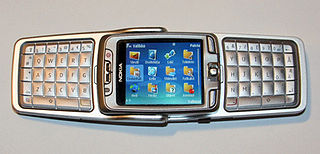
The Nokia E70 is a candybar/fold keyboard-type mobile phone from the Eseries range, announced in October 2005 and released in May 2006. There are two models of this phone, the E70-1 for the world market with tri-band GSM and UMTS, and the E70-2 for the Americas with tri-band GSM and EDGE packet data capability. Both models use the S60 platform 3rd Edition on top of Symbian OS version 9.1.

The Nokia N95 is a mobile phone produced by Nokia as part of their Nseries line of portable devices. Announced in September 2006, it was released to the market in March 2007. The N95 ran S60 3rd Edition, on Symbian OS v9.2. It has a two-way sliding mechanism, which can be used to access either media playback buttons or a numeric keypad. It was first released in silver and later on in black, with limited edition quantities in gold and purple. The launch price of the N95 was around €550.
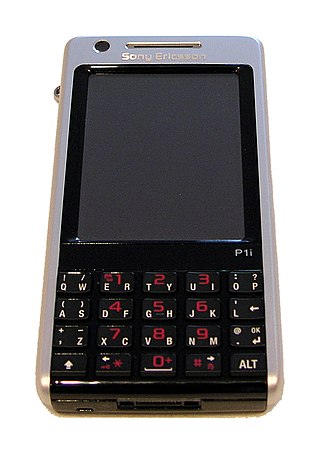
The Sony Ericsson P1 is a mobile phone and the successor of the P990. It was the last of the Sony Ericsson "P" Smartphone series, introduced in 2002 with the Sony Ericsson P800 and it integrates many of the hardware features of its predecessor the P990 in the form factor of the M600. It was announced on 8 May 2007. There is a Chinese version of P1 called P1c. Compare with P1/ P1i, P1c lacks of 3G, thereby using EDGE which is much slower but more available especially in the US and parts of Europe.
The Nokia 6000 series or Classic Business series is range of mobile phones marketed by Nokia. This family of phones is notable for their conservative, unisex designs, making them popular with business users.

Nokia 5300 XpressMusic is a slider mobile phone by Nokia, part of the XpressMusic range. It was introduced on 26 September 2006 and released at the end of that year. It runs on Nokia Series 40 3rd Edition FP2.

The Nokia N96 is a discontinued high-end mobile phone announced by Nokia on 11 February 2008 at the Mobile World Congress in Barcelona as part of the Nseries line. The N96 runs Symbian OS v9.3. It is compatible with the N-Gage 2.0 gaming platform and has a DVB-H TV tuner and AV output.
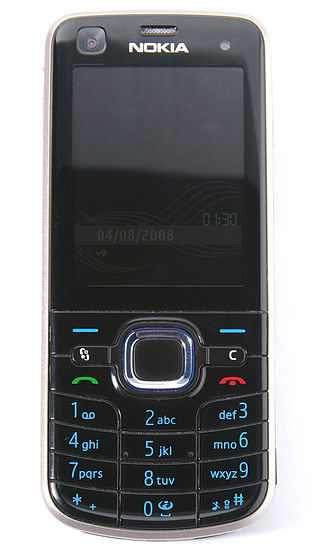
Nokia 6220 classic is a Symbian OS mobile phone announced by Nokia on 11 February 2008. It is notable for featuring a Xenon flash for its 5-megapixel camera, similar to Nokia N82 and often considered as a "budget" version of the N82. Despite its compact size, it offers features comparable to the Nseries lineup, though it lacks Wi-Fi and a 3.5 mm audio jack, probably to cut design and production costs.

The Nokia E71 is a mobile phone introduced on 8 May 2008 from the Eseries range with a QWERTY keyboard targeting business users worldwide. It runs on Symbian OS v9.2, with a Series 60 3rd Edition, second generation Feature Pack 1. The Nokia E71 succeeded the Nokia E61/61i models, building on the base design and form factor but enhancing on the feature set.

The Nokia 2600 classic is a Nokia Dual-band GSM phone E900/1800 or E850/1900 that includes a VGA camera, FM radio, Bluetooth, E-mail and mobile Internet access via a WAP browser. Additionally, the Nokia 2600 supports MMS and Nokia Xpress Audio Messaging, for recording and editing messages on the go. It also had a similar sliding variant called Nokia 2680 slide.
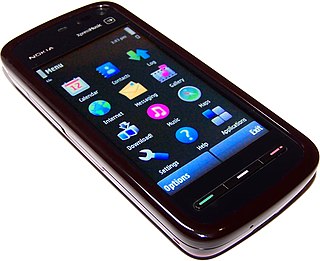
Nokia 5800 XpressMusic is a smartphone part of the XpressMusic line, announced by Nokia on 2 October 2008 in London and started shipping in November of that year. Code-named "Tube", it was the first touchscreen-equipped S60 device by Nokia – essentially it was the first device to run Symbian^1, also known as S60 5th Edition, the touch-specific S60-based platform created by the Symbian Foundation. The touchscreen features tactile feedback.

The Nokia E66 is a slider mobile phone in the Nokia Eseries range, a S60 platform third edition device with slide action targeting business users. It is a successor to the Nokia E65 with which it shares many features.

The Nokia 5320 XpressMusic is a Symbian OS S60 mobile phone, released by Nokia in 2008 as a part of their XpressMusic line of portable devices. The phone has a rugged candybar body with outlined keypads. It emphasizes music and multimedia playback. Among its highlights are a dedicated 3D audio chip for better sound quality, 24 hours of music playback, a 3.5 mm audio jack, N-Gage compatibility, and music/gaming keys. At the time of release the phone cost $220 in the U.S., European and Asian markets.

The Nokia 6700 classic is a mobile phone made by Nokia and successor of the 6300 and 6500 classic. It was announced in January 2009 and arrived on the European market in June that year. It has a stainless steel body and a chrome-covered keypad.
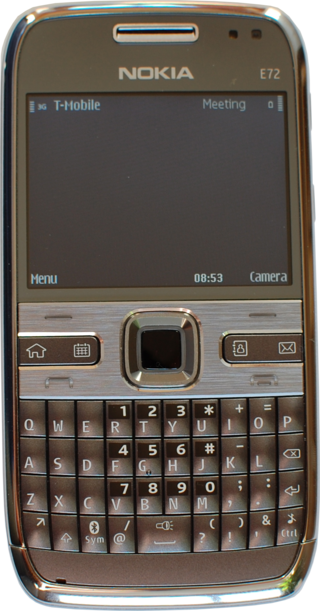
The Nokia E72 is a mobile phone from the Nokia Eseries range manufactured in Finland. The Nokia E72 was announced on June 15, 2009 at the Nokia Connections 2009 event in Singapore. It is the successor to the Nokia E71 and is based on a similar design and form factor, and offers a similar feature set. The Nokia E72 is a business-oriented phone and has standard features including mobile email, calendar and instant messaging among many others with its Symbian-based S60 3rd Edition Feature Pack 2 operating system.
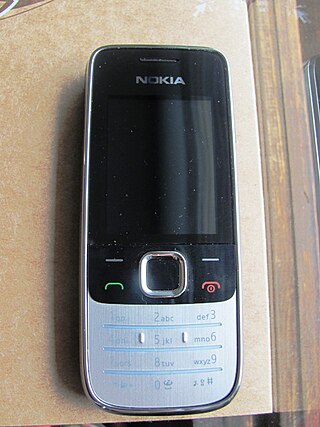
The Nokia 2730 classic is a Nokia Quad-band GSM/UMTS 3G cell phone that includes a camera, FM radio, Bluetooth, music and video player, as well as several internet-based applications.

The Nokia N8 is a touchscreen-based smartphone developed by Nokia. Announced on 27 April 2010, the Nokia N8 was the first device to run on the Symbian^3 mobile operating system and it was the company's flagship device for the year. It was released on 30 September 2010 at the Nokia Online Store before being released in markets around the world on 1 October 2010. There were two version made, the N8 and the N8-00. The N8 was made for Vodafone and locked to its networks, and the N8-00 was made by Microsoft and open network.






















